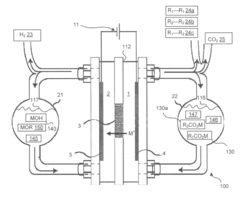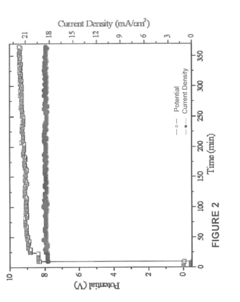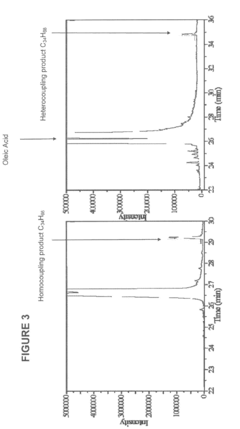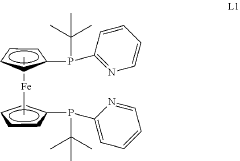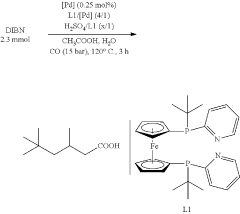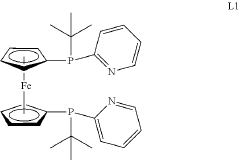Carboxylic Acid Integration in Cutting-Edge Analytical Technologies
JUL 31, 20259 MIN READ
Generate Your Research Report Instantly with AI Agent
Patsnap Eureka helps you evaluate technical feasibility & market potential.
Carboxylic Acid Tech Evolution and Objectives
Carboxylic acids have played a pivotal role in analytical chemistry for decades, serving as essential compounds in various scientific and industrial applications. The integration of carboxylic acids in cutting-edge analytical technologies has witnessed significant advancements, driven by the need for more precise, efficient, and versatile analytical methods.
The evolution of carboxylic acid-based analytical techniques can be traced back to the early 20th century, with the development of titration methods for acid-base analysis. As technology progressed, more sophisticated techniques emerged, such as gas chromatography (GC) and high-performance liquid chromatography (HPLC), which allowed for the separation and quantification of complex mixtures containing carboxylic acids.
In recent years, the field has experienced a paradigm shift with the advent of advanced spectroscopic and spectrometric techniques. Fourier-transform infrared spectroscopy (FTIR) and nuclear magnetic resonance (NMR) spectroscopy have revolutionized the structural analysis of carboxylic acids, providing detailed information about molecular composition and interactions.
The integration of carboxylic acids in mass spectrometry has opened new avenues for high-throughput analysis and metabolomics studies. Techniques such as electrospray ionization (ESI) and matrix-assisted laser desorption/ionization (MALDI) have enabled the detection and characterization of carboxylic acids in complex biological matrices with unprecedented sensitivity and specificity.
The primary objective of current research in this field is to develop more sensitive, selective, and rapid analytical methods for carboxylic acid detection and quantification. This includes the exploration of novel derivatization techniques to enhance the detectability of carboxylic acids in various analytical platforms.
Another key goal is the miniaturization and automation of carboxylic acid analysis, driven by the demand for portable and on-site testing capabilities. This has led to the development of microfluidic devices and lab-on-a-chip systems that integrate multiple analytical steps into a single, compact platform.
The integration of artificial intelligence and machine learning algorithms in data analysis and interpretation represents a promising frontier in carboxylic acid analytics. These technologies aim to improve the accuracy of compound identification and quantification, especially in complex mixtures and biological samples.
As environmental concerns gain prominence, there is a growing emphasis on developing green analytical methods for carboxylic acid analysis. This includes the use of environmentally friendly solvents, reduced sample sizes, and energy-efficient instrumentation.
The evolution of carboxylic acid-based analytical techniques can be traced back to the early 20th century, with the development of titration methods for acid-base analysis. As technology progressed, more sophisticated techniques emerged, such as gas chromatography (GC) and high-performance liquid chromatography (HPLC), which allowed for the separation and quantification of complex mixtures containing carboxylic acids.
In recent years, the field has experienced a paradigm shift with the advent of advanced spectroscopic and spectrometric techniques. Fourier-transform infrared spectroscopy (FTIR) and nuclear magnetic resonance (NMR) spectroscopy have revolutionized the structural analysis of carboxylic acids, providing detailed information about molecular composition and interactions.
The integration of carboxylic acids in mass spectrometry has opened new avenues for high-throughput analysis and metabolomics studies. Techniques such as electrospray ionization (ESI) and matrix-assisted laser desorption/ionization (MALDI) have enabled the detection and characterization of carboxylic acids in complex biological matrices with unprecedented sensitivity and specificity.
The primary objective of current research in this field is to develop more sensitive, selective, and rapid analytical methods for carboxylic acid detection and quantification. This includes the exploration of novel derivatization techniques to enhance the detectability of carboxylic acids in various analytical platforms.
Another key goal is the miniaturization and automation of carboxylic acid analysis, driven by the demand for portable and on-site testing capabilities. This has led to the development of microfluidic devices and lab-on-a-chip systems that integrate multiple analytical steps into a single, compact platform.
The integration of artificial intelligence and machine learning algorithms in data analysis and interpretation represents a promising frontier in carboxylic acid analytics. These technologies aim to improve the accuracy of compound identification and quantification, especially in complex mixtures and biological samples.
As environmental concerns gain prominence, there is a growing emphasis on developing green analytical methods for carboxylic acid analysis. This includes the use of environmentally friendly solvents, reduced sample sizes, and energy-efficient instrumentation.
Market Demand for Advanced Analytical Methods
The market demand for advanced analytical methods incorporating carboxylic acid integration has been steadily increasing across various industries. This growth is primarily driven by the need for more precise, efficient, and versatile analytical techniques in fields such as pharmaceuticals, environmental monitoring, food safety, and materials science.
In the pharmaceutical sector, there is a growing emphasis on developing more sensitive and accurate methods for detecting and quantifying carboxylic acid-containing compounds. These compounds play crucial roles in drug development, metabolism studies, and quality control processes. The demand for high-throughput screening techniques that can rapidly analyze large numbers of samples while maintaining high accuracy is particularly strong.
Environmental monitoring agencies and research institutions are seeking improved analytical methods to detect and measure carboxylic acids in air, water, and soil samples. These compounds are important indicators of pollution levels and can provide valuable insights into ecosystem health. The ability to detect trace amounts of carboxylic acids with high sensitivity and specificity is becoming increasingly important for regulatory compliance and environmental impact assessments.
In the food and beverage industry, there is a rising demand for advanced analytical techniques to ensure product quality and safety. Carboxylic acids are key components in many food products and can serve as indicators of freshness, flavor profiles, and potential contamination. Manufacturers and regulatory bodies are seeking rapid, reliable methods for detecting and quantifying these compounds to maintain quality standards and comply with stringent food safety regulations.
The materials science sector is also driving demand for advanced analytical methods involving carboxylic acids. These compounds are essential in the development of new polymers, coatings, and composite materials. Researchers and manufacturers require sophisticated analytical techniques to characterize the properties and behavior of carboxylic acid-containing materials under various conditions.
As industries continue to push the boundaries of innovation and quality control, there is a growing need for analytical methods that can provide real-time, in-situ measurements. This trend is driving the development of portable, user-friendly devices that incorporate carboxylic acid detection capabilities, allowing for on-site analysis in field applications.
The global market for analytical instruments is expected to experience significant growth in the coming years, with a substantial portion of this growth attributed to advancements in carboxylic acid integration technologies. This trend is further supported by increasing regulatory requirements across industries, which necessitate more sophisticated and reliable analytical methods.
In the pharmaceutical sector, there is a growing emphasis on developing more sensitive and accurate methods for detecting and quantifying carboxylic acid-containing compounds. These compounds play crucial roles in drug development, metabolism studies, and quality control processes. The demand for high-throughput screening techniques that can rapidly analyze large numbers of samples while maintaining high accuracy is particularly strong.
Environmental monitoring agencies and research institutions are seeking improved analytical methods to detect and measure carboxylic acids in air, water, and soil samples. These compounds are important indicators of pollution levels and can provide valuable insights into ecosystem health. The ability to detect trace amounts of carboxylic acids with high sensitivity and specificity is becoming increasingly important for regulatory compliance and environmental impact assessments.
In the food and beverage industry, there is a rising demand for advanced analytical techniques to ensure product quality and safety. Carboxylic acids are key components in many food products and can serve as indicators of freshness, flavor profiles, and potential contamination. Manufacturers and regulatory bodies are seeking rapid, reliable methods for detecting and quantifying these compounds to maintain quality standards and comply with stringent food safety regulations.
The materials science sector is also driving demand for advanced analytical methods involving carboxylic acids. These compounds are essential in the development of new polymers, coatings, and composite materials. Researchers and manufacturers require sophisticated analytical techniques to characterize the properties and behavior of carboxylic acid-containing materials under various conditions.
As industries continue to push the boundaries of innovation and quality control, there is a growing need for analytical methods that can provide real-time, in-situ measurements. This trend is driving the development of portable, user-friendly devices that incorporate carboxylic acid detection capabilities, allowing for on-site analysis in field applications.
The global market for analytical instruments is expected to experience significant growth in the coming years, with a substantial portion of this growth attributed to advancements in carboxylic acid integration technologies. This trend is further supported by increasing regulatory requirements across industries, which necessitate more sophisticated and reliable analytical methods.
Current Challenges in Carboxylic Acid Analysis
Despite significant advancements in analytical technologies, the integration of carboxylic acid analysis still faces several challenges. One of the primary obstacles is the wide range of carboxylic acids present in various samples, each with different physical and chemical properties. This diversity makes it difficult to develop a universal method for their detection and quantification.
The volatility of certain carboxylic acids poses another challenge, particularly in gas chromatography (GC) applications. Some short-chain carboxylic acids are highly volatile, leading to potential loss during sample preparation or analysis. Conversely, long-chain carboxylic acids may have low volatility, requiring derivatization steps that can introduce additional complexity and potential sources of error.
Matrix effects remain a significant hurdle in carboxylic acid analysis, especially in complex biological or environmental samples. These effects can interfere with the detection and quantification of target analytes, leading to inaccurate results. Overcoming matrix effects often requires extensive sample preparation or the development of more selective analytical methods.
The sensitivity of current analytical techniques for carboxylic acids is another area of concern. While some methods offer high sensitivity for certain carboxylic acids, they may fall short when analyzing trace levels of others. This limitation is particularly problematic in fields such as environmental monitoring or metabolomics, where the detection of low concentrations is crucial.
Chromatographic separation of structurally similar carboxylic acids continues to be challenging. Isomers and homologues often exhibit similar retention times, making their resolution difficult. This issue is compounded when dealing with complex mixtures containing multiple carboxylic acids, necessitating the development of more sophisticated separation techniques.
The stability of carboxylic acids during analysis is another critical challenge. Some acids may undergo degradation or transformation during sample preparation or analysis, leading to inaccurate results. This is particularly problematic for labile compounds or when dealing with harsh analytical conditions.
Quantification accuracy remains a concern, especially when dealing with a wide dynamic range of carboxylic acid concentrations in a single sample. Calibration can be challenging due to the diverse nature of these compounds and potential matrix effects, often requiring the use of multiple internal standards or advanced calibration techniques.
Lastly, the integration of carboxylic acid analysis into high-throughput screening platforms presents logistical and technical challenges. Balancing the need for rapid analysis with maintaining accuracy and sensitivity is an ongoing struggle, particularly in fields such as drug discovery or metabolomics where large numbers of samples need to be processed quickly.
The volatility of certain carboxylic acids poses another challenge, particularly in gas chromatography (GC) applications. Some short-chain carboxylic acids are highly volatile, leading to potential loss during sample preparation or analysis. Conversely, long-chain carboxylic acids may have low volatility, requiring derivatization steps that can introduce additional complexity and potential sources of error.
Matrix effects remain a significant hurdle in carboxylic acid analysis, especially in complex biological or environmental samples. These effects can interfere with the detection and quantification of target analytes, leading to inaccurate results. Overcoming matrix effects often requires extensive sample preparation or the development of more selective analytical methods.
The sensitivity of current analytical techniques for carboxylic acids is another area of concern. While some methods offer high sensitivity for certain carboxylic acids, they may fall short when analyzing trace levels of others. This limitation is particularly problematic in fields such as environmental monitoring or metabolomics, where the detection of low concentrations is crucial.
Chromatographic separation of structurally similar carboxylic acids continues to be challenging. Isomers and homologues often exhibit similar retention times, making their resolution difficult. This issue is compounded when dealing with complex mixtures containing multiple carboxylic acids, necessitating the development of more sophisticated separation techniques.
The stability of carboxylic acids during analysis is another critical challenge. Some acids may undergo degradation or transformation during sample preparation or analysis, leading to inaccurate results. This is particularly problematic for labile compounds or when dealing with harsh analytical conditions.
Quantification accuracy remains a concern, especially when dealing with a wide dynamic range of carboxylic acid concentrations in a single sample. Calibration can be challenging due to the diverse nature of these compounds and potential matrix effects, often requiring the use of multiple internal standards or advanced calibration techniques.
Lastly, the integration of carboxylic acid analysis into high-throughput screening platforms presents logistical and technical challenges. Balancing the need for rapid analysis with maintaining accuracy and sensitivity is an ongoing struggle, particularly in fields such as drug discovery or metabolomics where large numbers of samples need to be processed quickly.
Existing Carboxylic Acid Integration Solutions
01 Synthesis of carboxylic acids
Various methods for synthesizing carboxylic acids are described, including oxidation of primary alcohols or aldehydes, hydrolysis of nitriles, and carbonylation reactions. These processes often involve catalysts and specific reaction conditions to achieve high yields and selectivity.- Synthesis of carboxylic acids: Various methods for synthesizing carboxylic acids are described, including oxidation of primary alcohols or aldehydes, hydrolysis of nitriles, and carbonylation reactions. These processes often involve catalysts and specific reaction conditions to achieve high yields and selectivity.
- Carboxylic acid derivatives and applications: Carboxylic acids can be converted into various derivatives such as esters, amides, and anhydrides. These derivatives have wide-ranging applications in industries including pharmaceuticals, polymers, and fine chemicals. The synthesis and use of these derivatives are explored in several patents.
- Purification and separation of carboxylic acids: Methods for purifying and separating carboxylic acids from reaction mixtures or natural sources are described. These techniques may include crystallization, distillation, extraction, and chromatographic methods, aimed at obtaining high-purity carboxylic acids for various applications.
- Carboxylic acids in polymer chemistry: Carboxylic acids play a crucial role in polymer chemistry, serving as monomers or modifiers in the production of various polymers. Patents describe the use of carboxylic acids in polyester synthesis, polymer crosslinking, and the development of functional polymers with specific properties.
- Industrial applications of carboxylic acids: Carboxylic acids find diverse applications in various industries. Patents describe their use as intermediates in the production of pharmaceuticals, as additives in personal care products, as components in lubricants and surfactants, and as reagents in organic synthesis for the production of fine chemicals.
02 Derivatives and applications of carboxylic acids
Carboxylic acids serve as precursors for various derivatives such as esters, amides, and anhydrides. These compounds find applications in pharmaceuticals, polymers, and industrial processes. The synthesis and properties of these derivatives are explored in several patents.Expand Specific Solutions03 Purification and separation techniques
Methods for purifying and separating carboxylic acids from reaction mixtures or natural sources are described. These techniques include crystallization, distillation, extraction, and chromatography, aimed at obtaining high-purity carboxylic acids for various applications.Expand Specific Solutions04 Carboxylic acids in polymer chemistry
The use of carboxylic acids in polymer synthesis and modification is explored. This includes their role as monomers, chain terminators, and functional groups for post-polymerization modifications. Applications in adhesives, coatings, and biodegradable materials are also discussed.Expand Specific Solutions05 Environmental and green chemistry aspects
Patents addressing the environmental impact of carboxylic acid production and use are included. This covers green synthesis methods, biodegradable alternatives, and processes for reducing waste and emissions in industrial applications of carboxylic acids.Expand Specific Solutions
Key Players in Analytical Instrument Industry
The integration of carboxylic acid in cutting-edge analytical technologies is currently in a growth phase, with the market expanding rapidly due to increasing demand in various industries. The global market size for this technology is projected to reach significant figures in the coming years, driven by advancements in pharmaceutical, chemical, and environmental sectors. The technology's maturity varies across applications, with some areas more developed than others. Companies like Daicel Corp., Evonik Operations GmbH, and Applied Biosystems LLC are at the forefront, leveraging their expertise in chemical manufacturing and analytical instrumentation to push the boundaries of carboxylic acid integration. Academic institutions such as Changzhou University and East China Normal University are also contributing to research and development, fostering innovation in this field.
Applied Biosystems LLC
Technical Solution: Applied Biosystems LLC has developed advanced analytical technologies integrating carboxylic acid detection for high-throughput screening and metabolomics studies. Their liquid chromatography-mass spectrometry (LC-MS) systems employ innovative ion-pairing techniques to enhance separation and detection of carboxylic acids[1]. The company's latest QuantStudio Real-Time PCR platforms incorporate carboxylic acid-based fluorescent probes for improved sensitivity in gene expression analysis[2]. Additionally, their capillary electrophoresis systems utilize carboxylic acid buffer additives to optimize the separation of charged biomolecules[3].
Strengths: High sensitivity and specificity for carboxylic acid detection, versatile applications in genomics and metabolomics. Weaknesses: Complex instrumentation may require specialized training, higher cost compared to traditional methods.
BASF Corp.
Technical Solution: BASF Corp. has pioneered the integration of carboxylic acids in analytical technologies for industrial applications. They have developed a novel surface-enhanced Raman spectroscopy (SERS) platform using carboxylic acid-functionalized gold nanoparticles for ultra-sensitive detection of environmental pollutants[4]. BASF's innovative gas chromatography columns incorporate carboxylic acid-modified stationary phases, enabling improved separation of complex mixtures in petrochemical analysis[5]. The company has also introduced carboxylic acid-based chemosensors for real-time monitoring of metal ions in industrial processes[6].
Strengths: Robust technologies suitable for harsh industrial environments, wide range of applications from environmental monitoring to process control. Weaknesses: May require significant capital investment, potential limitations in biological sample analysis.
Innovative Approaches in Carboxylic Acid Detection
Device and method for aryl-alkyl coupling using decarboxylation
PatentInactiveUS20130245347A1
Innovation
- An electrochemical decarboxylation process using alkali salts of carboxylic acids to form radicals for coupling, allowing for the production of alkylated aromatic compounds under mild conditions with CO2 and H2 as by-products, enabling control over the degree of alkylation.
Process for pd-catalyzed hydroxycarbonylation of diisobutene: sulfuric acid/ligand ratio
PatentInactiveUS20190194112A1
Innovation
- A process involving the sequential addition of diisobutene, a Pd compound capable of forming complexes, a ligand L1, acetic acid, sulfuric acid in a specific ratio, and carbon monoxide, followed by heating, to convert diisobutene into a compound P1, optimizing reaction conditions such as temperature and pressure.
Environmental Impact of Analytical Technologies
The integration of carboxylic acid analysis in cutting-edge analytical technologies has significant environmental implications that warrant careful consideration. These advanced techniques, while offering enhanced precision and efficiency in detecting and quantifying carboxylic acids, also present potential environmental challenges and benefits.
One of the primary environmental concerns associated with these technologies is the use of hazardous chemicals and solvents in sample preparation and analysis processes. Many analytical methods require organic solvents or strong acids, which can pose risks to ecosystems if not properly managed. However, recent advancements in green chemistry approaches have led to the development of more environmentally friendly alternatives, such as aqueous-based extraction methods and the use of ionic liquids as greener solvents.
Energy consumption is another critical factor to consider. High-performance liquid chromatography (HPLC) and gas chromatography (GC) systems, commonly used for carboxylic acid analysis, can be energy-intensive. This increased energy demand contributes to higher carbon footprints. Nevertheless, technological improvements in instrument design and the adoption of more energy-efficient components have helped mitigate this impact to some extent.
The disposal of analytical waste presents an additional environmental challenge. Used columns, contaminated glassware, and spent reagents require proper handling and disposal to prevent environmental contamination. Many laboratories have implemented comprehensive waste management protocols, including recycling programs for solvents and proper treatment of hazardous waste, to address these concerns.
On the positive side, the enhanced sensitivity and accuracy of modern analytical technologies for carboxylic acid detection can contribute to improved environmental monitoring and protection. These advanced techniques enable the detection of trace amounts of pollutants in water, soil, and air samples, facilitating more effective environmental remediation efforts and regulatory compliance.
Furthermore, the development of miniaturized and portable analytical devices for carboxylic acid analysis has led to reduced sample sizes and reagent consumption. This trend not only minimizes waste generation but also allows for on-site analysis, reducing the need for sample transportation and associated carbon emissions.
The integration of automation and high-throughput screening capabilities in these technologies has also indirectly benefited the environment by increasing analytical efficiency. This improvement reduces the overall resource consumption per analysis and allows for more comprehensive environmental monitoring programs.
In conclusion, while the environmental impact of carboxylic acid integration in cutting-edge analytical technologies presents some challenges, ongoing innovations in green chemistry, energy efficiency, and waste management are actively addressing these concerns. The enhanced capabilities of these technologies for environmental monitoring and protection underscore their potential to contribute positively to environmental sustainability when implemented responsibly.
One of the primary environmental concerns associated with these technologies is the use of hazardous chemicals and solvents in sample preparation and analysis processes. Many analytical methods require organic solvents or strong acids, which can pose risks to ecosystems if not properly managed. However, recent advancements in green chemistry approaches have led to the development of more environmentally friendly alternatives, such as aqueous-based extraction methods and the use of ionic liquids as greener solvents.
Energy consumption is another critical factor to consider. High-performance liquid chromatography (HPLC) and gas chromatography (GC) systems, commonly used for carboxylic acid analysis, can be energy-intensive. This increased energy demand contributes to higher carbon footprints. Nevertheless, technological improvements in instrument design and the adoption of more energy-efficient components have helped mitigate this impact to some extent.
The disposal of analytical waste presents an additional environmental challenge. Used columns, contaminated glassware, and spent reagents require proper handling and disposal to prevent environmental contamination. Many laboratories have implemented comprehensive waste management protocols, including recycling programs for solvents and proper treatment of hazardous waste, to address these concerns.
On the positive side, the enhanced sensitivity and accuracy of modern analytical technologies for carboxylic acid detection can contribute to improved environmental monitoring and protection. These advanced techniques enable the detection of trace amounts of pollutants in water, soil, and air samples, facilitating more effective environmental remediation efforts and regulatory compliance.
Furthermore, the development of miniaturized and portable analytical devices for carboxylic acid analysis has led to reduced sample sizes and reagent consumption. This trend not only minimizes waste generation but also allows for on-site analysis, reducing the need for sample transportation and associated carbon emissions.
The integration of automation and high-throughput screening capabilities in these technologies has also indirectly benefited the environment by increasing analytical efficiency. This improvement reduces the overall resource consumption per analysis and allows for more comprehensive environmental monitoring programs.
In conclusion, while the environmental impact of carboxylic acid integration in cutting-edge analytical technologies presents some challenges, ongoing innovations in green chemistry, energy efficiency, and waste management are actively addressing these concerns. The enhanced capabilities of these technologies for environmental monitoring and protection underscore their potential to contribute positively to environmental sustainability when implemented responsibly.
Regulatory Framework for Analytical Instruments
The regulatory framework for analytical instruments incorporating carboxylic acid integration is a complex and evolving landscape. Regulatory bodies worldwide have established stringent guidelines to ensure the safety, efficacy, and reliability of these advanced technologies. In the United States, the Food and Drug Administration (FDA) plays a pivotal role in overseeing analytical instruments used in pharmaceutical and clinical settings. The FDA's Center for Devices and Radiological Health (CDRH) is responsible for regulating medical devices, including analytical instruments that utilize carboxylic acid integration.
The European Union has implemented the In Vitro Diagnostic Regulation (IVDR), which came into full effect in May 2022. This regulation significantly impacts analytical technologies, including those incorporating carboxylic acid detection methods. The IVDR introduces more stringent requirements for clinical evidence, post-market surveillance, and traceability of devices throughout the supply chain.
In Japan, the Pharmaceuticals and Medical Devices Agency (PMDA) oversees the regulation of analytical instruments. The Japanese regulatory framework emphasizes the importance of quality management systems and requires manufacturers to demonstrate the safety and performance of their devices through rigorous testing and documentation.
International standards, such as ISO 13485 for quality management systems in medical devices, play a crucial role in harmonizing regulatory requirements across different regions. Manufacturers of analytical instruments integrating carboxylic acid technologies must adhere to these standards to ensure global market access and compliance.
Regulatory bodies are increasingly focusing on the validation and verification of analytical methods involving carboxylic acids. This includes requirements for method development, optimization, and performance characteristics such as accuracy, precision, linearity, and robustness. Manufacturers must provide comprehensive validation data to support the claims of their instruments.
The regulatory landscape also addresses data integrity and cybersecurity concerns associated with modern analytical technologies. As these instruments often generate and store large volumes of sensitive data, regulations mandate robust data management systems and protection against unauthorized access or manipulation.
Environmental considerations are becoming more prominent in regulatory frameworks. Analytical instruments utilizing carboxylic acid integration must comply with regulations regarding the disposal of chemical waste and energy efficiency standards. This aligns with broader sustainability initiatives in the scientific and industrial sectors.
As the field of carboxylic acid integration in analytical technologies continues to advance, regulatory bodies are adapting their frameworks to keep pace with innovation. This includes the development of guidance documents and standards specific to novel analytical techniques and the establishment of expert panels to assess emerging technologies.
The European Union has implemented the In Vitro Diagnostic Regulation (IVDR), which came into full effect in May 2022. This regulation significantly impacts analytical technologies, including those incorporating carboxylic acid detection methods. The IVDR introduces more stringent requirements for clinical evidence, post-market surveillance, and traceability of devices throughout the supply chain.
In Japan, the Pharmaceuticals and Medical Devices Agency (PMDA) oversees the regulation of analytical instruments. The Japanese regulatory framework emphasizes the importance of quality management systems and requires manufacturers to demonstrate the safety and performance of their devices through rigorous testing and documentation.
International standards, such as ISO 13485 for quality management systems in medical devices, play a crucial role in harmonizing regulatory requirements across different regions. Manufacturers of analytical instruments integrating carboxylic acid technologies must adhere to these standards to ensure global market access and compliance.
Regulatory bodies are increasingly focusing on the validation and verification of analytical methods involving carboxylic acids. This includes requirements for method development, optimization, and performance characteristics such as accuracy, precision, linearity, and robustness. Manufacturers must provide comprehensive validation data to support the claims of their instruments.
The regulatory landscape also addresses data integrity and cybersecurity concerns associated with modern analytical technologies. As these instruments often generate and store large volumes of sensitive data, regulations mandate robust data management systems and protection against unauthorized access or manipulation.
Environmental considerations are becoming more prominent in regulatory frameworks. Analytical instruments utilizing carboxylic acid integration must comply with regulations regarding the disposal of chemical waste and energy efficiency standards. This aligns with broader sustainability initiatives in the scientific and industrial sectors.
As the field of carboxylic acid integration in analytical technologies continues to advance, regulatory bodies are adapting their frameworks to keep pace with innovation. This includes the development of guidance documents and standards specific to novel analytical techniques and the establishment of expert panels to assess emerging technologies.
Unlock deeper insights with Patsnap Eureka Quick Research — get a full tech report to explore trends and direct your research. Try now!
Generate Your Research Report Instantly with AI Agent
Supercharge your innovation with Patsnap Eureka AI Agent Platform!
